Why You Should Monitor Your SEO Content Performance and How To Do It
Topic: SEO
Published:
Written by: Bernard Huang
Unlike social media posts that can disappear once there’s enough new content in your feed, search engine optimization (SEO) content continues to deliver results long after you’ve published it. The median age of a No. 1 ranked content page on Google is 3.5 years.
That said, high-ranking articles need to stay relevant to maintain their top spots. To that end, it’s important to monitor your existing content and refresh it when needed to ensure long-term success. As you continue to publish pieces to your website, this might seem like an overwhelming task. But you can do it efficiently with the right tools.
Keep reading to learn how monitoring SEO performance can benefit your content marketing strategy and how to use technology to automate your SEO content monitoring.
What is SEO performance monitoring?
SEO monitoring is the process of tracking your website’s visibility and ranking on search engines like Google and figuring out actions you can take to improve your performance. Common metrics to track include organic traffic, SERP position, and click-through rate (CTR).
For brands with a content-based SEO strategy, monitoring SEO performance means more than tracking your website’s homepage. You’ll also want to continually monitor key metrics for each of your content pages by seeing how well they perform for the relevant keywords.
Since there are myriad metrics and pages to track in this process, most companies automate their SEO monitoring. We’ll dive into the best tools for keeping an eye on your content’s search performance later. First, let’s look at why it’s important to keep tracking your overall website and individual content pages.
The importance of monitoring SEO performance
"Monitoring is vital to your SEO strategy’s success because it lets you know if you’re achieving your objectives, provides insight into what your website does well, and helps you understand where you need to improve."
For content marketing, tracking changes in your content performance enables you to be proactive about refreshing your content to continue to rank high and take advantage of higher CTRs.
At this point, you may be wondering, “Is content monitoring worth it when I also have to focus on generating new posts?”
The answer is yes.
Even small changes in your search engine results page (SERP) rank can have a significant impact on your organic traffic. A First Page Sage study found that the average CTR for the first position on Google is 39.8%. It drops to 18.7% for the URL in the second position.
In other words, falling from first to second cuts the CTR by more than 50% on average.
There’s more. After the top three positions, the average CTRs drop below 10%. When you multiply the CTR by the monthly traffic volume for your keywords, you can see a significant difference in your organic traffic based on your ranking.
If your primary keyword has a monthly volume of 1,000, any CTR lower than 10% means that the post may bring in a few dozen visitors per month. In contrast, the top three positions, which have an average CTR of more than 10%, are more likely to drive 100 or more organic visitors.
"One benefit of SEO monitoring is that it enables you to take advantage of the low-hanging fruit in your content strategy. Often, updating existing articles takes less work than writing entirely new pieces, meaning you can boost your results without spending as much time and resources."
So, what metrics should you keep an eye on? Let’s take a look.
Metrics to track for SEO content
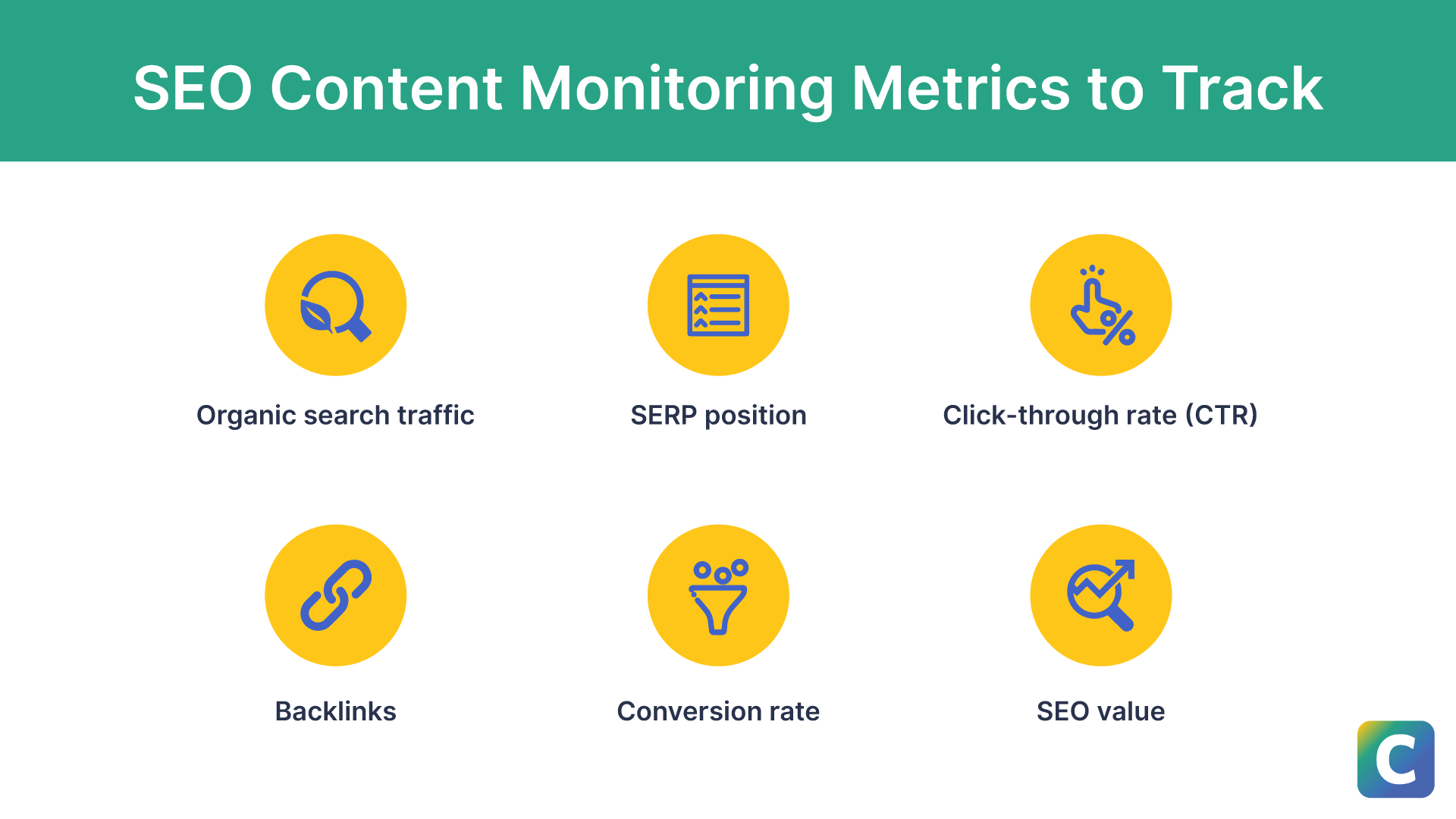
SEO content monitoring metrics.
Here’s a list of the most important SEO metrics to track when monitoring your content pages.
1. Organic traffic
Organic traffic is the number of people who visit your website because they clicked on your article on a SERP. Specifically, it measures the traffic you get from unpaid clicks, as opposed to visitors from paid ads on Google. It’s one of the most common key performance indicators (KPIs), used by 86% of B2B content marketers.
Organic search traffic is a valuable metric to track since it has a better return on investment (ROI) than buying pay-per-click (PPC) ads. One study found that after three years, SEO (organic traffic) had an average ROI of 748%, while paid search (inorganic) was only 36%.
The organic traffic you generate from each post depends on factors like the search volume of the target keywords, your SERP position, and the CTR.
2. SERP position
SERP position refers to your ranking in search engine results, and it indicates how your piece performs compared to the competition. It’s also a measure of how well you address the search intent of the keyword by providing relevant and useful information for readers.
Google uses several ranking factors to determine the order of results on search pages. One of the ways you can improve your SERP ranking is by following Google’s E-E-A-T guidelines for creating high-quality, relevant content that’s helpful to users.
3. CTR
The CTR refers to the percentage of searchers who click through to your URL after seeing it in a SERP. The main factors that influence CTR are your brand’s reputation as well as your page’s SERP position, meta title, and meta description.
Higher CTRs lead to more organic traffic and overall visitors to your website, which can ultimately result in more conversions and revenue.
4. Backlinks
Backlinks are the links from referring domains that point to your article. They establish your domain and content as authoritative in the eyes of Google’s algorithms. A high SERP position can help you get more backlinks since other content marketers will come across your posts when researching and writing their own content.
In addition to backlinks, your internal linking strategy is helpful for Google since it helps search engines understand the context of your content.
5. Conversion rate
Conversion rate is the percentage of readers who click on one of your pages and then take the desired action, such as signing up for a demo or subscribing to your email list.
Your conversion rate measures how well your SEO content performs in terms of delivering marketing and sales leads. Higher conversion rates suggest you’re targeting the right keywords and providing value.
6. SEO value
SEO value is an estimate of the money generated by the organic traffic that your article generates. It takes your sales conversion rates and revenue per conversion into account and helps provide insight into the ROI of your SEO efforts.
Tracking SEO value is an important distinction because low-funnel keywords may have less volume but higher conversion rates. In other words, it’s helpful to understand the organic traffic and SEO value delivered by a piece.
Top-of-funnel (TOFU) articles may drive more traffic but fewer conversions and revenue. Having both types of content is essential to turn SEO success into income.
This is an especially important metric for reporting to stakeholders and other business leaders to help them understand the ROI of SEO content marketing.
If you see your performance trend downward in one or more of these KPIs, you may need to update one of your posts. But before you do that, it’s helpful to understand why your rankings and other KPIs change in the first place.
Reasons why SERP rankings change

Reasons why SERP rankings change.
Organic search results are dynamic, and they can change over time, which means you can’t take your positions for granted.
Some of the most common causes of SERP position changes are:
Algorithm changes: When the algorithms change, ranking factors and their impact on your position may shift, causing another piece to outrank one of yours or vice versa. The tactics you used before may not be as effective after an algorithm change. For instance, the helpful content update of 2022 resulted in better performance for websites that provide a better user experience for the reader instead of writing for search engine algorithms.
Content decay: When there are new products or findings related to your keyword, you may have old pieces fall in position if you don’t update them. One example is TikTok becoming an important related keyword for the topic of social media marketing.
Change in user intent: Changes in the meaning of a keyword or its primary search intent can impact rankings. For example, AI-related keywords might be moving from primarily informational intent to partially commercial intent as more AI-based products enter the market. If your existing page addresses the old intent, it will be less relevant as users’ needs evolve.
New competitor pieces: If someone else publishes a more comprehensive article and their brand has a good domain reputation, they may outrank you. Competitors that do SEO content monitoring and keep their existing posts up to date can increase their chances of outperforming you if you aren’t doing the same.
Keyword cannibalization: If you publish two pieces that target the same primary keyword, Google can have a hard time figuring out which one to rank higher. This can lead to your articles swapping places or your ranking falling compared to a competitor that doesn’t have the same issue.
Any of these issues can affect your content’s SERP position, leading to fewer people going to your website and converting into customers. The good news is you can use SEO performance monitoring to track KPIs and address any problems before they significantly affect your traffic.
Here are a few tools that can make content monitoring easier.
Best SEO monitoring tools
Manually monitoring the SEO performance of each piece of content can be incredibly time-consuming, especially when you consider that you get the most insights with continuous monitoring.
These are some of the best SEO tools to help you automate your content monitoring and keyword rankings.
Clearscope
Clearscope is an AI-powered SEO content optimization platform that helps you write better articles and webpages using real-time search and competitive insights. The software includes a Content Inventory feature that lets you automate your SEO content monitoring and track KPIs based on specific keywords.
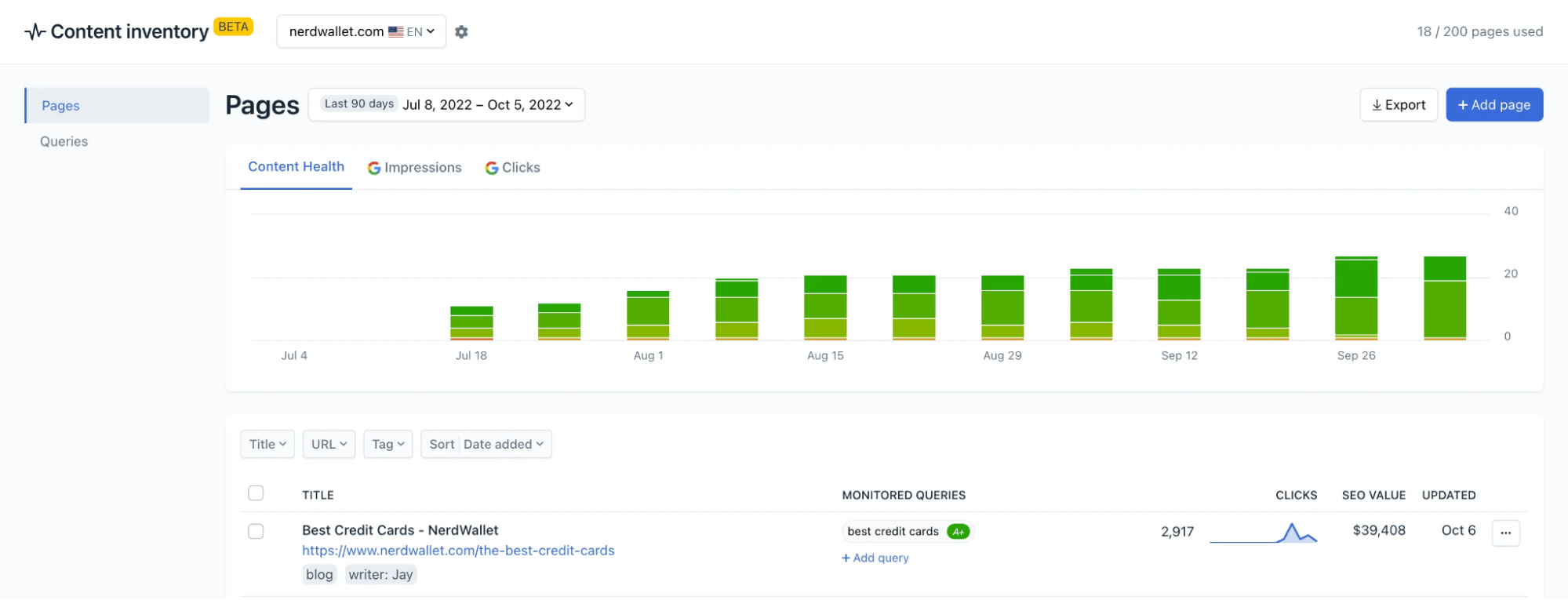
Clearscope’s Content Inventory Pages dashboard.
With Content Inventory, you can monitor the SEO performance of existing blog posts on a monthly basis. You’ll see organic traffic, content grade, and SEO value on a monthly basis.
When you view your inventory metrics, the graph makes it easy to identify which posts have lower content scores and might require edits, which is especially helpful for addressing issues like content decay and changes in user intent.
Best for: Optimizing SEO content and tracking quality and organic traffic of existing content pieces.
Google Search Console
Google Search Console is a free tool that helps you monitor your brand’s overall performance in search results, including tracking individual webpages. You can use the Performance report to track valuable metrics, including impressions, clicks, CTR, and SERP position.

Google Search Console’s Performance report.
You can customize reports with filters and get a detailed look at your content’s performance based on dimensions like date or geographic location.
Best for: Understanding total impressions and CTRs.
Ahrefs
Ahrefs is a keyword research and SEO tracking tool you can use along with tools like Clearscope to optimize your content and website performance. In addition to finding keyword insights and measuring technical SEO metrics, you can use Ahrefs to monitor content performance.
The Rank Tracker tool helps measure your website’s overall visibility, as well as the average position, volume, and organic website traffic for your chosen search queries. It will also show if you’re ranking for SERP features, like featured snippets or shopping results.
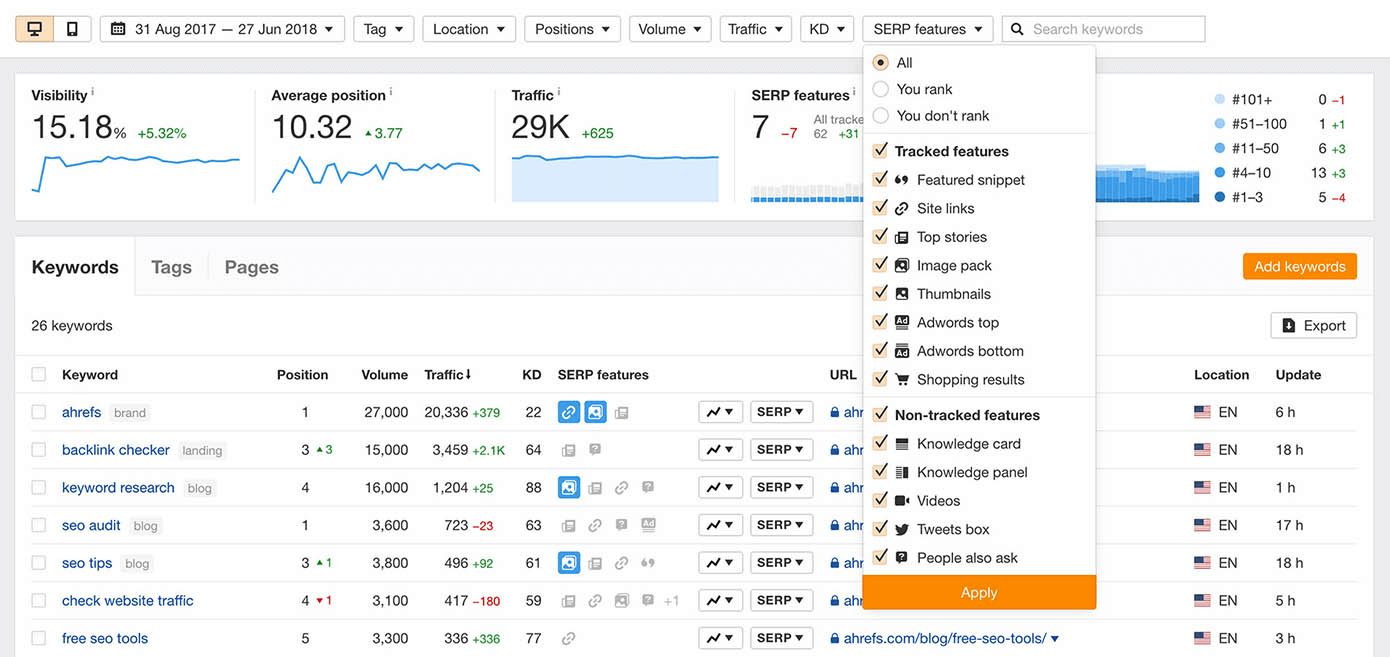
Ahrefs’ Rank Tracker dashboard (image source).
Best for: Search visibility and SERP rank tracking by keyword.
Semrush
Semrush is a versatile digital marketing platform that includes tools for SEO, PPC, and social media. Its SEO monitoring capabilities include position tracking, local SEO, link building, and competitor SEO analysis.
The backlink toolkit is especially helpful when used in addition to content refreshes, as it includes analytics, audits, and link-building opportunities. Building backlinks from referring domains improves your off-page SEO and signals to Google that your website is an authority on the given topic.

Semrush’s backlink audit dashboard (image source).
Best for: Position tracking and backlink building.
Monitoring SEO content performance with Clearscope
Clearscope’s Content Inventory tool automatically tracks the performance of your existing content and makes it available to you in a user-friendly dashboard. It can help you do a full SEO content audit, but it’s also valuable as a tool for ongoing monitoring.
To automatically track your existing content, add the URLs of the specific pages to your repository in Clearscope’s Content Inventory, and the tool takes care of the rest.
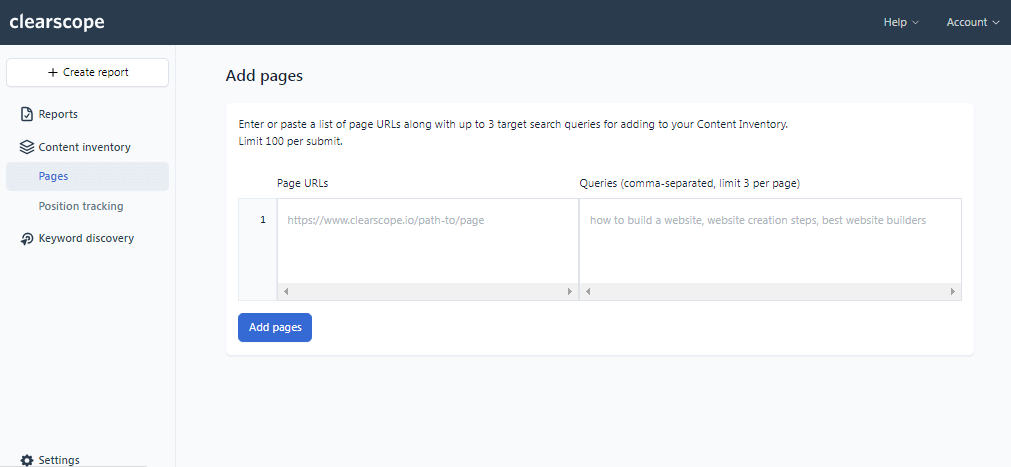
Clearscope’s Content Inventory.
For each page you add, the dashboard shows the following information:
Clicks: Number of organic search clicks.
Date last updated: Last time you updated the page.
SEO value: Dollar value of the organic search traffic generated by the piece.
Content grade: Current score based on the insights in Clearscope’s SEO draft for the primary keyword.
The data you see in Content Inventory updates monthly, so you have timely information about each content piece.
Tracking your content grade is especially helpful because it means you can see when the relevance of your piece drops based on important keywords. This is because each month, you see how your piece performs based on the most recent insights for the primary keyword.
For example, if the post scored an A+ when you originally published it, but information about the topic has evolved since then, you may see the score go down to a B or lower. When this happens, you may want to investigate how you can improve. That gives you the opportunity to re-optimize content before it affects your SEO rankings, traffic, and ROI.
Using Clearscope to refresh content and improve rankings
The monitored grades in Clearscope’s Content Inventory make it easy to see which pieces need a refresh. If an article that originally scored highly has now dropped a letter grade or two, it’s time to update.
Some pieces may only need a light refresh, while others might require a more thorough rewrite.
Content refreshes may include updating statistics to be current or adding a single section to address one or two important keywords.
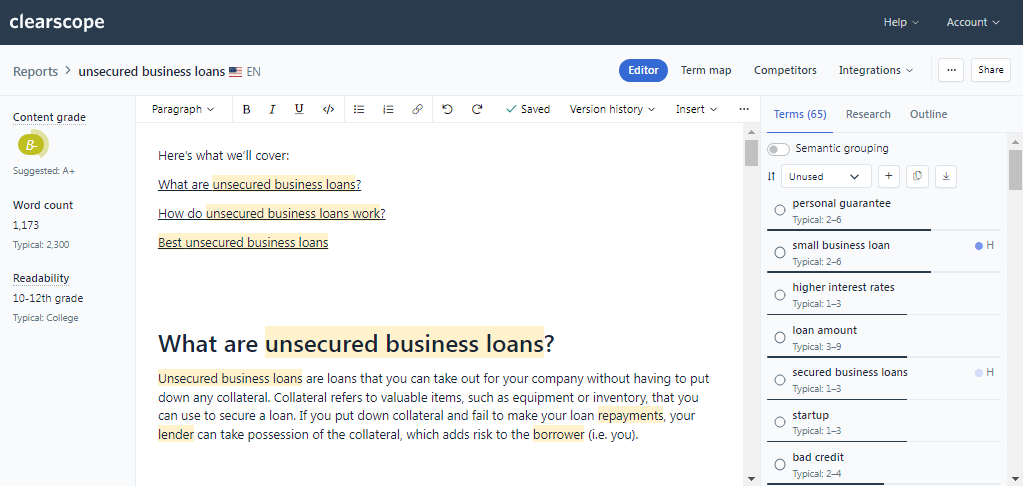
Clearscope’s Editor, a content optimization platform.
In contrast, rewrites involve more changes, such as adding multiple sections or even consolidating a couple of articles that cover the same topic.
Once you’ve noticed an article’s grade has declined, you can open the Clearscope draft and find actionable recommendations to improve the content.
Within the Clearscope Editor, you’ll be able to see:
Related topics
Relevant FAQs
Unused keywords
Ideal reading level
Recommended word count
Outlines for the top-ranking pieces
Keyword usage comparison with top-ranking pieces
Use the Editor to bring your content score up higher and then republish. This way, you may not have to do hefty site content audits as frequently. Instead, you can use a data-driven strategy for ongoing content refreshes that helps you continually optimize your SEO results.
Final thoughts: Why you should monitor the SEO performance of your content
Content marketing goes hand in hand with SEO. That said, SEO can be highly competitive, with competitors publishing new pieces or updating their articles regularly. As a result, it’s crucial to keep an eye on the performance of your existing pieces so you can make the most out of the content you already have.
Not to mention, updating existing content doesn’t take nearly as long as researching, writing, and editing new posts. Including refreshes and new articles in your editorial calendar can help you make the most out of limited time and resources.
For an AI-powered tool that automatically tracks content and provides data-driven recommendations for content optimization, explore Clearscope today.
5 SEO Monitoring Tools | Track Website & Content Performance
Our buyer's guide covers 5 essential SEO monitoring tools to audit website health, stay ahead of SEO issues, and improve your performance in search engines.
Read moreWhat are the best content optimization tools?
In need of a content optimization tool? Check out our guide of the best content optimization tools on the market.
Read moreHow to Create a Content Inventory & Perform a Content Audit
Our post explains how to perform a content inventory, audit your existing website content, and maintain an SEO-optimized site — in four simple steps.
Read more